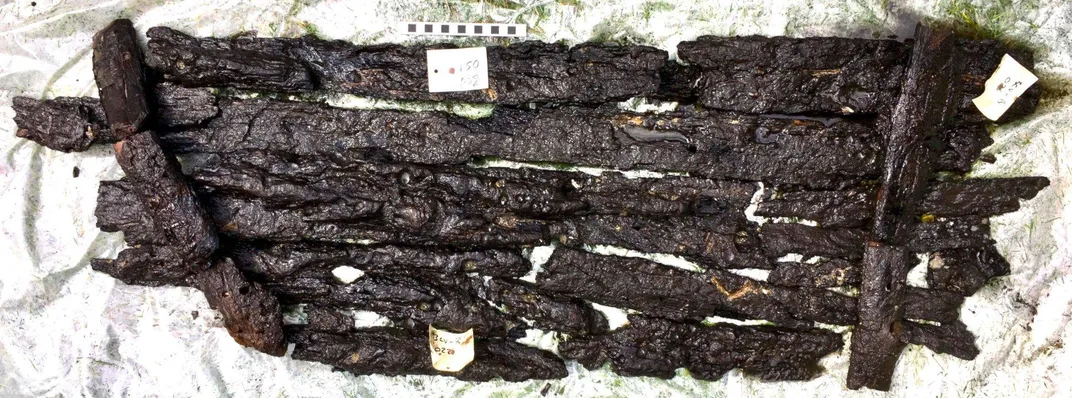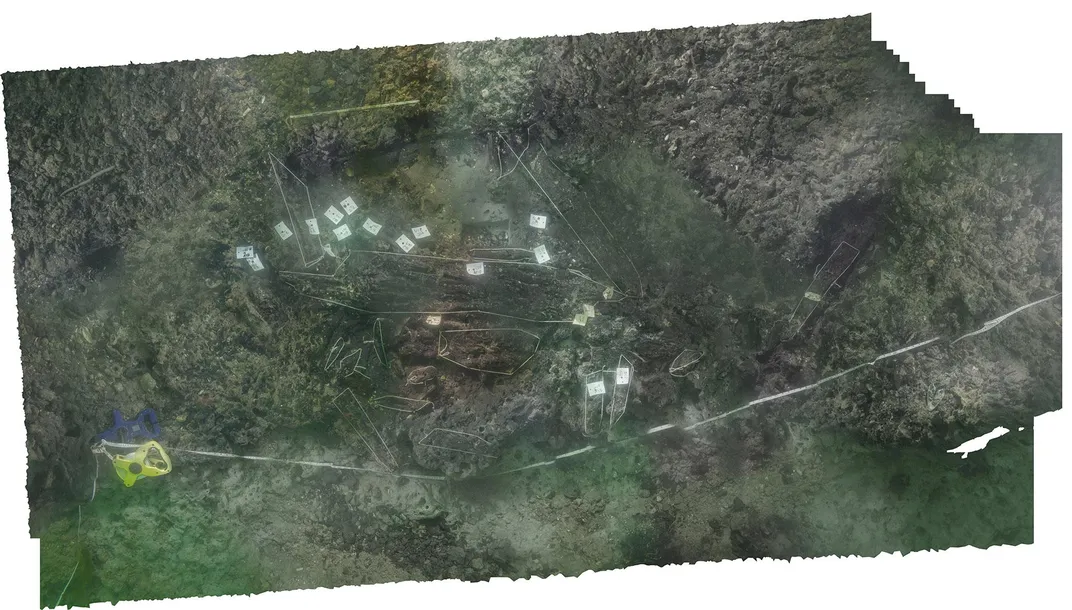An 8,000-Year-Old Platform in Britain Could Be the Oldest Boat-Building Site Ever Discovered
The Stone Age platform, where log boats may have been constructed, reveals early knowledge of advanced wood working techniques
Archaeologists diving at a site on the Isle of Wight, just off the south coast of England, have found the remains of a wooden platform dating back 8,000 years. If, as researchers believe, it was used to build log boats, the site would be the oldest known boat-building site in the world.
In 1999, divers found a lobster excavating a burrow on the seafloor near Bouldnor Cliff on the Isle of Wight. The lobster wasn’t just chucking rocks out its front door—archaeologists realized some of the stones were flints worked by Stone Age people. Soon, excavations revealed an ancient coastal site stretching about two thirds of a mile with various structures and artifacts and five major sites. Among the finds, researchers have discovered the oldest piece of string and the oldest wheat found in the U.K., which pushed back the history of agriculture on the island by 2,000 years. In 2005, they discovered a pile of timbers they believed was a wooden platform used for shipbuilding.
This spring, further investigations at the shipbuilding site revealed another, more intact wooden platform made of cut timbers set on top of wooden foundations. Carbon dating reveals that the timbers are 8,000 years old.
“As a feature by itself it’s quite incredible,” Garry Momber, director of the Maritime Archaeological Trust, the non-profit in charge of the excavations, tells Ryan F. Mandelbaum at Gizmodo. “This is the most cohesive, intact structure from the Middle Stone Age ever recovered in the United Kingdom.”
According to a press release, the find doubles the amount of Stone Age worked wood found in the U.K. The most striking thing about the platform, however, is the technique used to construct it. Researchers didn’t believe many of the construction methods used to make the platform developed until much later. “The site contains a wealth of evidence for technological skills that were not thought to have been developed for a further couple of thousand years, such as advanced wood working,” Momber says.
Though the site now lies completely submerged, the platform was on dry land when it was built. The Isle of Wight and the rest of Great Britain were connected to mainland Europe via a now submerged landmass called Doggerland. Early humans likely used this causeway to Europe for various waves of migration into the British Isles. The Bouldnor-Butser Mesolithic Woodworking Project, an experimental archaeology project attempting to build log boats similar to those believed to be produced at the site, explains that the climate was changing during this period of history. As the Ice Age waned, rivers were becoming wider, lakes got bigger and the seas expanded. Around 8,200 years ago, Doggerland completely disappeared, turning Britain into an island. In this increasingly marine environment, boat building would have taken on increased importance. The site was likely constructed on the bank of semi-stable river that has long since been reclaimed by the ocean.
Not everyone, however, believes the platforms were used for building boats. “Whilst I love the idea that this is the oldest boat-building site in the world (which chimes so well with the maritime heritage of the Isle of Wight), I would be tentative of making this claim from the wooden timbers discovered,” archaeologist Helen Farr of the University of Southampton tells Gizmodo. “However, a platform or walkway would fit with what I would expect from other known sites of this age.”
Whatever the purpose of the platform, the Bouldner Cliff site, sometimes called Britain’s Atlantis, has rewritten the island’s ancient past over 20 years of fieldwork. However, the same thing that keeps revealing new structures and artifacts, coastal erosion, also threatens to wash away the sediments that have preserved so much extraordinary organic material.
According to the press release, the elements of the new platform have been transferred to the British Ocean Sediment Core Research facility operated by the National Oceanography Centre which will keep the wood cold and wet to prevent decay. The wood will be desalinated for preservation and then examined closely for things like cut marks, engravings and other signs of the ancient people who constructed it millennia ago.
/https://tf-cmsv2-smithsonianmag-media.s3.amazonaws.com/filer/32/2b/322b1088-9633-4a32-af83-520d9e8d143f/bouldner_3.jpg)

